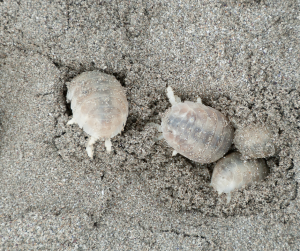 Living on Long Island, family beach days are part of the summer season! Unfortunately, even visiting the best beaches on Long Island to soak up some sun can result in encounters with unwanted fellow beachgoers—beach bugs. If your summer beach day plans don’t include laying on your towel with beach pests, fear not. It’s possible to take advantage of our beautiful local beaches without heading home with a ton of bug bites.
Living on Long Island, family beach days are part of the summer season! Unfortunately, even visiting the best beaches on Long Island to soak up some sun can result in encounters with unwanted fellow beachgoers—beach bugs. If your summer beach day plans don’t include laying on your towel with beach pests, fear not. It’s possible to take advantage of our beautiful local beaches without heading home with a ton of bug bites.
As pest control experts in Long Island, our team at Suburban Exterminating wants to help you stay informed. Below are five of the top beach bugs commonly found on Long Island.
Sand Fleas
What Are Sand Fleas?
Contrary to what their name suggests, sand fleas, also known as mole crabs, aren’t even insects, but actually crustaceans, lumping them into the same subphylum as other beach creatures like crabs, lobsters, crayfish, and barnacles. You may hear them be called beach fleas, sand hoppers, or beach hoppers. They’re actually likely referred to as sand fleas because they jump around in a similar fashion as regular ‘ole fleas.
What Do Sand Fleas Look Like?
Sand fleas are very small, ranging from about a quarter of an inch to an inch in length. Usually, they’re gray, green, or brown, with several pairs of legs and long antennae. They also have two forked appendages which protrude from their backs.
Where Are Sand Fleas Usually Found?
Sand fleas are typically found in—you guessed it—sand, but more specifically, moist sandy areas underneath rocks or debris near the high-tide mark.
Do Sand Fleas Bite?
While both beach hoppers and mole crabs are sometimes referred to as “sand fleas,” it’s important to note that they are different organisms. Neither beach hoppers nor mole crabs pose a biting threat to humans. If you are experiencing bites, it could be from other insects or, in some cases, parasitic sand fleas (like Tunga penetrans), which are a separate category and can cause discomfort.
Can Sand Fleas Be Found in Homes?
While you won’t find sand fleas when you are at home, you may encounter a different type of flea that your pet brings home. If that happens Suburban Exterminating is here to help with flea and tick control services you can trust. Give us a call!
Beach Isopods
What Are Beach Isopods?
Beach isopods, or as they’re usually called, roly polies or pill bugs, are another common pest you may encounter on Long Island’s beaches.
Where Are Beach Isopods Commonly Found?
Typically, these critters live in the moist high tide line area where they burrow in the sand.
Do Beach Isopods Bite?
Aside from being a bit creepy, roly polies are fairly harmless and don’t bite.
Can Isopods Be Found in Homes?
Yes, a variety of isopod species, such as the roly-poly, can be found in homes. If you are dealing with an isopod infestation in Long Island, call Suburban Exterminating today.
Sand Flies
What Are Sand Flies?
Kelp flies, or sand flies as they’re often called, are often seen in beach areas with driftwood, seaweed, and surf grass in search of kelp. Sand flies are often seen in groups, sometimes near other scavengers like red mites.
Do Sand Flies Bite?
Yes, sand flies can bite. They are small insects that feed on the blood of mammals, including humans. Their bites can be itchy, and in some regions, they may transmit diseases like Leishmaniasis. To avoid bites, use insect repellent and wear protective clothing when in areas where sand flies are common.
Sand Lice
What Are Sand Lice?
“Sand lice” is a term that may refer to sand fleas or beach hoppers, which are small crustaceans found on sandy beaches. They are not true lice but are harmless and do not pose a threat to humans.
The term “Sea lice” can also refer to small marine organisms found in oceans, including larval jellyfish or tiny crustaceans. Contact with them while swimming can cause skin irritation, known as “seabather’s eruption,” resulting in a rash or itching. Rinse off after swimming in areas where sea lice are present and consider wearing protective clothing.
Mosquitoes
Mosquitoes thrive and breed in areas of standing water, and are often seen in beaches with ample sources of fresh standing water. Mosquitoes at the beach are more likely to be seen at later times in the day, such as twilight. Their bites can cause itchiness and general discomfort, but mosquitoes can also spread serious, often fatal diseases to humans through their bites, including Zika virus, West Nile virus, Chikungunya virus, dengue, and malaria.
Unfortunately, mosquitos are quite common around properties as well. If you are dealing with a mosquito infestation around your property, call Suburban Exterminating! We offer comprehensive mosquito control services.
Beach Spiders
Spiders are often found around aquatic environments, making the beach a prime spot for spiders like beach wolf spiders, dock spiders, and sea spiders. Here are a few of the most commonly seen beach spiders around te Long Island area:
- Beach Wolf Spiders: Beach wolf spiders are often found in the sand or under driftwood. These pests are experts at hiding and will bite if they are provoked. While their bites are both poisonous and painful, they are not deadly.
- Dock Spiders: Dock spiders, also often referred to as fishing spiders, feed off fish, so they’re often found near the water. These spiders actually rest their front two legs in the water to feel the vibrations of fish and tadpoles that are swimming in the area. Once it gets cold outside, dock spiders will be in search of warmth, so they will try to make their way inland or into houses. Their bites are poisonous, though they don’t often bite humans. If they do, humans generally aren’t impacted too severely by their bites, unless they happen to be sensitive to their venom.
- Sea Spiders: Sea spiders, which are not arachnids, but instead, pycnogonids, can be found in both shallow waters or thousands of feet underwater! They are carnivorous and seek out prey such as sea sponges and coral. While they don’t bite, sea spiders do have claws literally growing out of their brains. The sea spiders you’ll see on the beach are usually very small, but there are some true sea spider monsters that live deep in the ocean which can easily span a foot long (or more).
Unfortunately, spiders are quite common household pests as well. If you are dealing with spiders in your home or business, especially if the sightings are frequent, it may be time to consider professional spider control services.
6 Ways to Avoid Summer Insects on the Beach
- This one’s a given—when you’re thinking of what to pack for a day at the beach and want to prevent beach bug bites, don’t forget to take your insect repellant! Apply a layer of bug spray before the beach pests can get to you, and just like your sunscreen, be sure to reapply if it gets washed away in the water.
- Stay away from areas where beach pests are likely to be found. For example, avoid fresh standing water, which as mentioned previously, is a common breeding ground for mosquitoes.
- Bring a change of clothes, and do a wardrobe change before getting back to your car to ensure you don’t bring home any pests in your clothes or car. Be sure to wash your beach clothes as soon as possible when you get home, too!
- Take advantage of outdoor showers, and hose down yourself and your family on your way out. Bugs can end up hiding in places like your hair, and will gladly hitch a ride home with you given the opportunity.
- Maintain a year-round pest control maintenance service at your house to ensure if beach bugs do make their way into your home, you’re covered. Suburban Exterminating’s services protect Long Island homes from over 25 different pests, including common beach pests like spiders and mosquitoes. Contact us today to get started with your custom pest treatment plan.

